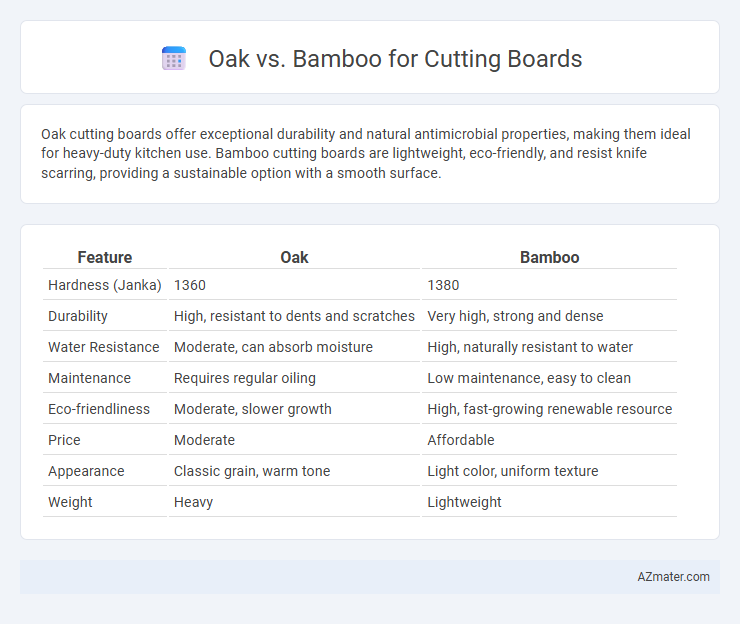Oak cutting boards offer exceptional durability and natural antimicrobial properties, making them ideal for heavy-duty kitchen use. Bamboo cutting boards are lightweight, eco-friendly, and resist knife scarring, providing a sustainable option with a smooth surface.
Table of Comparison
| Feature | Oak | Bamboo |
|---|---|---|
| Hardness (Janka) | 1360 | 1380 |
| Durability | High, resistant to dents and scratches | Very high, strong and dense |
| Water Resistance | Moderate, can absorb moisture | High, naturally resistant to water |
| Maintenance | Requires regular oiling | Low maintenance, easy to clean |
| Eco-friendliness | Moderate, slower growth | High, fast-growing renewable resource |
| Price | Moderate | Affordable |
| Appearance | Classic grain, warm tone | Light color, uniform texture |
| Weight | Heavy | Lightweight |
Introduction to Oak and Bamboo Cutting Boards
Oak cutting boards offer exceptional hardness and durability, making them resistant to deep knife marks and ideal for heavy-duty kitchen use. Bamboo cutting boards stand out for their eco-friendly sustainability, natural antimicrobial properties, and lighter weight, which provides easy handling and maintenance. Both materials deliver unique benefits, with oak prized for strength and grain aesthetic, while bamboo excels in renewable sourcing and moisture resistance.
Material Composition: Oak vs Bamboo
Oak cutting boards feature a dense hardwood composition with tight grain structures, offering durability and resistance to knife marks. Bamboo cutting boards consist of fast-growing grass fibers compressed into hard surfaces, providing a lightweight yet strong material with natural antimicrobial properties. Oak's dense fibers absorb less moisture compared to bamboo's porous, fibrous structure, affecting longevity and maintenance requirements.
Durability and Longevity Comparison
Oak cutting boards exhibit exceptional durability due to their dense grain structure, making them highly resistant to scratches and dents during prolonged use. Bamboo boards offer impressive longevity as well, benefiting from their natural hardness and fast-growing sustainability, but they tend to be slightly less resilient against deep cuts compared to oak. Both materials resist moisture effectively, but oak's tighter grain reduces warping over time, ensuring a longer lifespan for heavy kitchen use.
Knife-Friendliness: Which is Gentler on Blades?
Bamboo cutting boards are generally gentler on knife blades due to their softer, more flexible fibers that reduce dulling over time compared to denser hardwoods like oak. Oak boards, while durable and sturdy, have a tighter grain structure that can cause knives to dull faster with frequent use. Choosing bamboo preserves blade sharpness longer, making it an ideal option for maintaining knife longevity.
Maintenance and Cleaning Requirements
Oak cutting boards require regular oiling with food-safe mineral oil to prevent drying and cracking, and should be cleaned with mild soap and warm water without soaking to maintain durability. Bamboo boards are naturally more resistant to moisture and bacteria, making them easier to clean with simple wiping and occasional oiling to preserve their surface. Both materials need prompt drying and avoidance of dishwasher use to extend their lifespan and maintain hygiene.
Sustainability and Environmental Impact
Oak cutting boards offer durability and resistance to knife marks, but require longer growth cycles, which can impact deforestation rates. Bamboo cutting boards are faster-growing and more renewable, absorbing CO2 efficiently and reducing environmental footprint through rapid harvest cycles. Choosing bamboo contributes to sustainability efforts by minimizing habitat disruption and promoting resource regeneration compared to traditional hardwoods like oak.
Aesthetic Differences: Looks and Styles
Oak cutting boards showcase a rich, warm grain with prominent patterns that enhance rustic and traditional kitchen decor, offering durability and a classic appeal. Bamboo cutting boards feature a lighter, uniform color with a smooth, contemporary texture that fits minimalist and modern kitchen designs while being eco-friendly. The distinct visual contrasts between oak's natural, textured look and bamboo's sleek, consistent surface provide versatile style options for different aesthetic preferences.
Cost and Value for Money
Oak cutting boards typically cost more upfront due to the hardwood's density and durability, offering long-lasting performance with minimal wear. Bamboo cutting boards are generally more affordable, making them an economical choice while still providing good hardness and resistance to knife marks. For value for money, oak stands out for longevity and repairability, whereas bamboo appeals to budget-conscious buyers with sustainable and lightweight features.
Pros and Cons of Oak Cutting Boards
Oak cutting boards offer exceptional durability due to their dense hardwood structure, making them resistant to deep scratches and wear over time. Their natural grain provides antimicrobial properties, but oak's coarse texture can sometimes harbor bacteria if not properly maintained and dried. While oak boards are generally less prone to warping compared to softer woods, they require regular oiling to prevent cracking and maintain optimal cutting surface integrity.
Pros and Cons of Bamboo Cutting Boards
Bamboo cutting boards are prized for their eco-friendly and renewable nature, offering high durability and resistance to knife scarring, which helps maintain a smooth surface over time. They tend to be lighter and less porous than oak, reducing the risk of bacterial absorption and making them easier to clean; however, bamboo can be more prone to cracking and requires careful maintenance with oiling to prevent dryness. Despite being harder than oak, bamboo's hardness may dull knives faster, posing a trade-off between board longevity and blade sharpness.

Infographic: Oak vs Bamboo for Cutting Board
 azmater.com
azmater.com